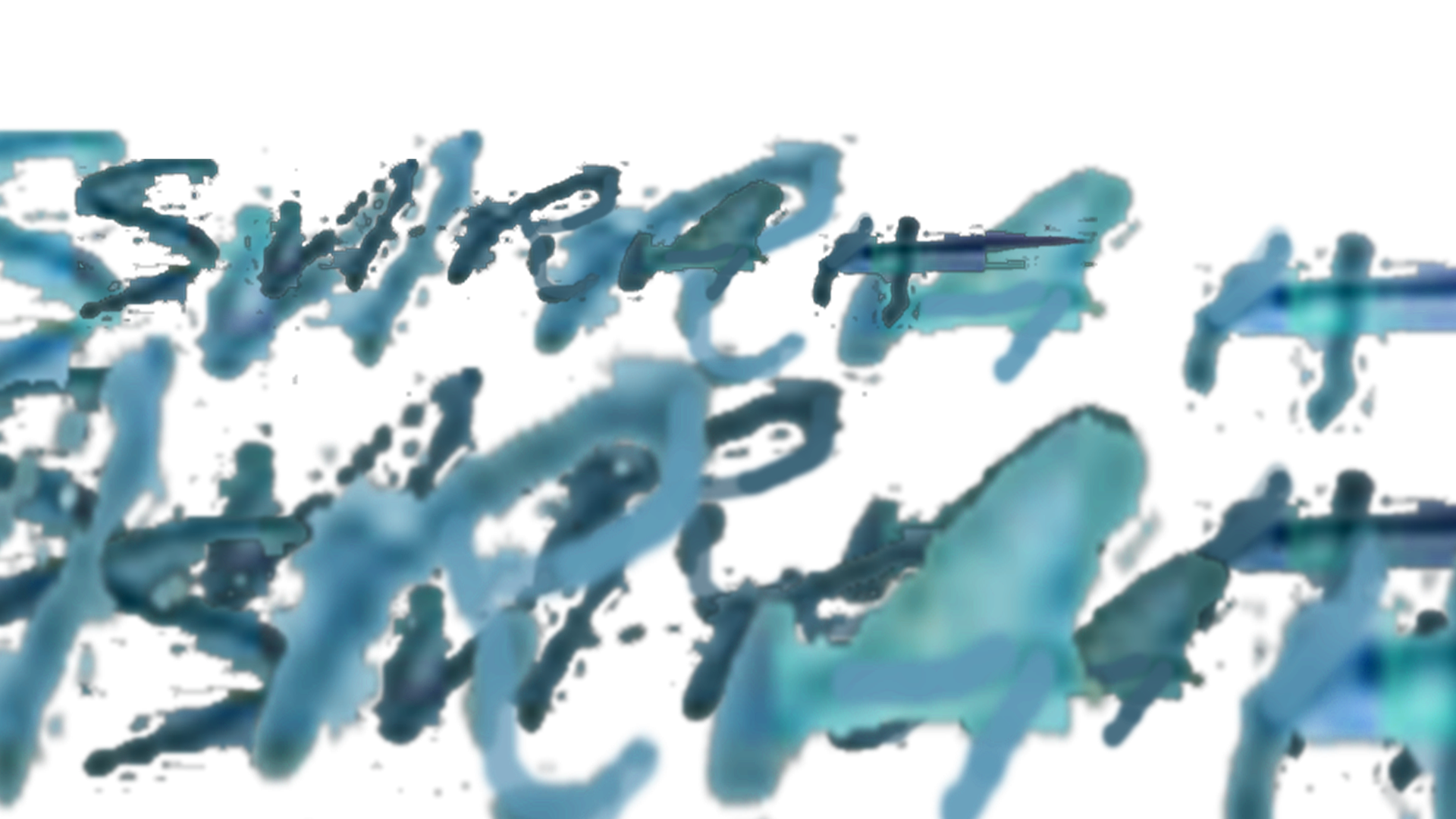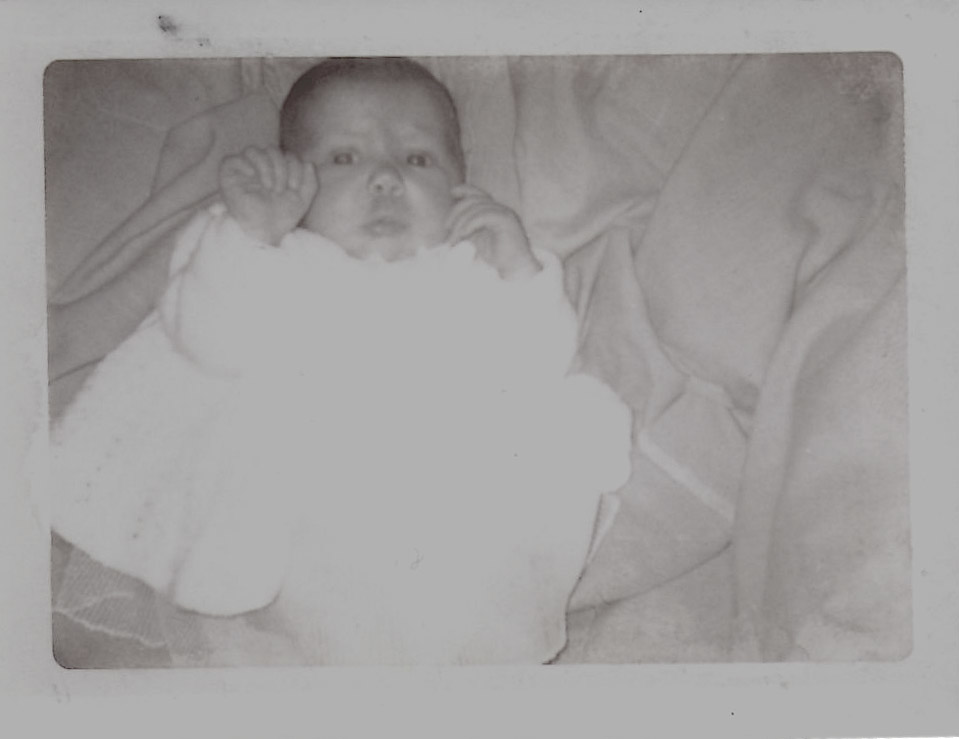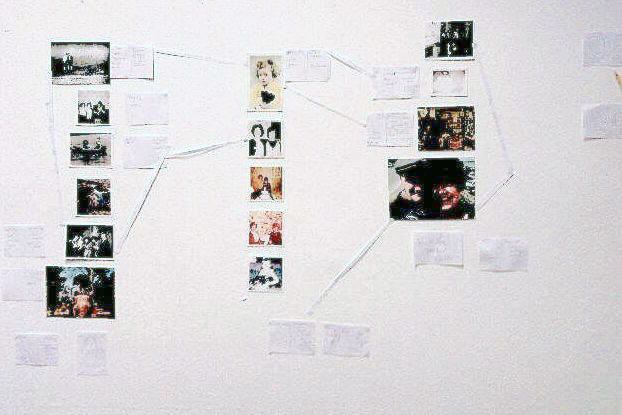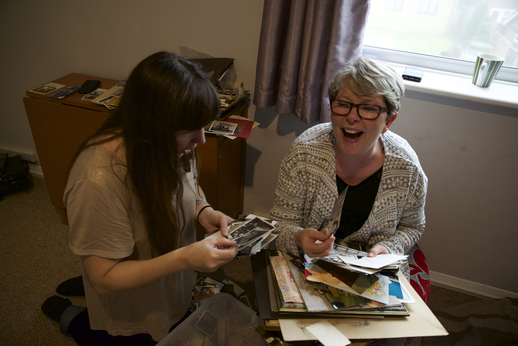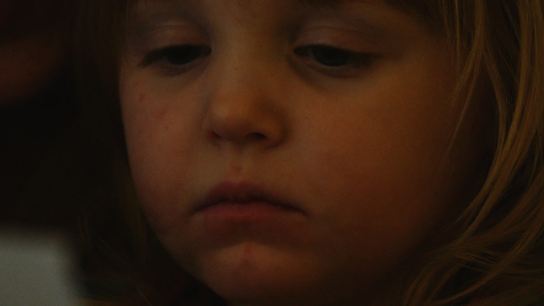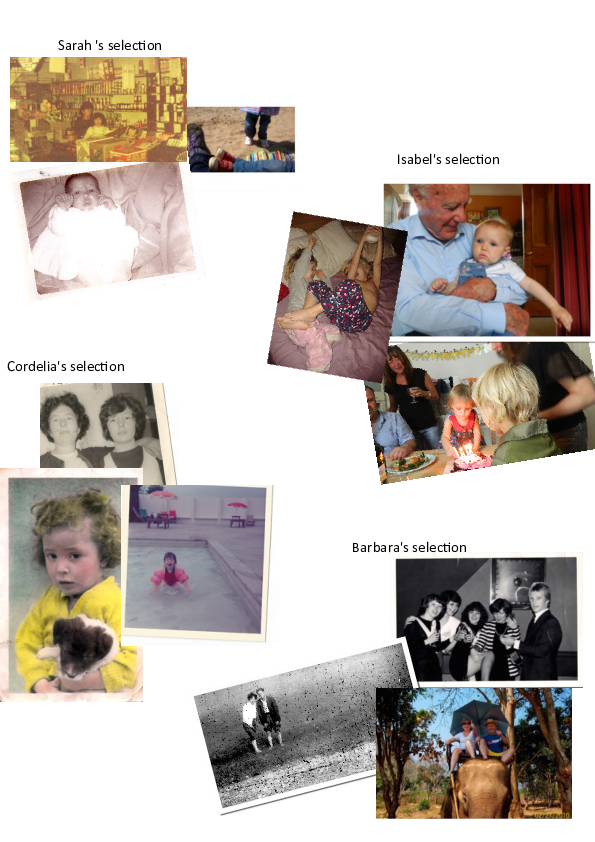Documentation of 31 Days Old (2016). This film gently documents the live performance as it was shown in my family home. A series of films, soundscapes, interviews and live moments were situated and installed in rooms across the whole house.
[1] See contemporary debates relating to collaboration in Noyale Colin and Stefanie Sachsenmaier`s co-edited Collaboration in Performance Practice (2016) which focuses on collaborative practices in the arts. Colin and Sachsenmaier highlight the recent emphasis placed on problematising collaborative processes across a diverse range of performance disciplines (2015).
I performed (43), along with my mother Cordelia (65), auntie Barbara (56) and my daughter Isabel (3), and presented narrations through film, soundscapes and digital technology which were situated in my family home.
In this research, it is the personal and the shared family memories of women in my maternal line that form the focus. The initial process involved these female family members choosing family photographs to work with, exploring them as mnemonic devices. This created thematic content, which was primarily developed through a sequence of interviews designed to explore the images for memory and meaning. This led to a series of narrative scores, which were further explored as the basis for creating performance.
I designed a one-on-one interview format, to respond to and engage with the personal conditions of the interviewer and the participant. The interviews were informal, held in private, and could be stopped and resumed at any time. During the process, I asked that the photograph be hand-held for a memory prompt or as a pretext of memory. This approach was to stimulate an experiencing of the weight and texture of the photograph, and thus encourage emotional connotations to provide an effective response in recalling memory. For example, the photographs chosen by my mother and auntie were taken directly out of the family album; some of the images were old, dog-eared and written over, whereas most of mine and Isabel’s images were printed images from computer files holding hundreds of photographs. Although this may not have impacted directly upon the act of remembering, I could see the reverence and the care taken over holding the images as if holding and touching the memory and the people themselves.
Some of the memories triggered during these sessions were intimate and presented questions as to whether they should be publicly shared. This decision primarily rested in the hands of the owner of the memory. Studying the family album in this way produced a series of tensions. Patricia Holland and Jo Spence state, in their interpretation of family pictures, that the difficulty in negotiating the family photograph can be a “potential site for conflict” (1991: 2). They discuss their interpretations of family pictures, which are in essence difficult to negotiate, as they are an entanglement of “private fantasy and public history” (1991: 2). In particular, Holland (1991) alludes to secret tensions and relationships between family members that only members of that family would be able to see. She asks the question, “does one want to include pictures in the album that reveal tensions as they are not the memories we want to project into the future?”
The Family Ties Network is a group of artists, filmmakers and writers who explore memory, space, place and the family in photography and moving image. On of their members, Suze Adams (2012), explores how memory confronts imagination where there is a tension between facts and fiction. Such concerns were evident within my own research, whereby, as within the series exploring mother ethics, I had to decide whether we as a family wanted to share and reveal certain family narratives, tensions or secrets. My aim in relation to these issues was to openly discuss and share our thoughts and parameters of the project with all involved. This led to a decision-making process about what would, and what would not, be shared. This enacts an ethical commitment which reinforces that each person has agency in the ways they are represented.
After all the interviews were conducted and the materials gathered, Andy and I listened to the chosen narratives. We began to isolate phrases and sections into themes and stories. Our method was inspired by Kristin Langellier and Eric Peterson’s (2004) approach in selecting sections of aural narratives so as to retain the feel of the telling. Andy and I preserved the false starts, repetitions and self-interruptions, where the struggle to remember can be heard, whilst at the same time keeping the speaker’s original meaning and intention. The main aim of this phase was to generate narrative recordings, which could serve as frameworks or scores for solo work. This process revealed a particular way of working with family, guided by the principal intention of sensitively recording and listening to personal and family memories. This form of working, I suggest, is a key feature of this practice; the actions of interviewing, collecting stories and conversing with family about their lived experience.
31 Days Old sits within part of an ongoing examination. I look at this work primarily from an artistic perspective – as a composer I develop musical material from sound recordings and interviews, marrying sound with visual material and making decisions about presentation, for example installation or curation of sound around the house – and these issues are driven by the collaborative process of working with my own family in our own living space.
My focus within 31 Days Old, was to gather sound materials from recorded interviews, centred on intergenerational family memories and narratives. The role of the curator takes the fore, and I am acutely aware of presenting material with care and sensitivity while at the same time staying true to an emerging artistic aesthetic.
Hence the recordings were used in a variety of ways, sometimes to reveal the stories being told (The Birth Stories- installation), at other times omitting the human voice altogether (Barbara's Theme - installation). As they are my relatives, my artistic decisions come from that perspective – I am entangled in all of these stories in some way and I am acutely aware of the need to represent them in an ethical and sensitive way. There is a duality of roles here. These are not my stories directly so I am collector and curator, but it is my family and I exercise the appropriate care in processing and presenting the material entrusted to me. All discussions and interviews were recorded consensually and with the interviewees’ knowledge that they may be used in a variety of ways.
My approach to memory draws upon scholarship by Annette Kuhn, whose notion of 'memory work' (2002-2010) is a recontextualisation of personal and cultural memory. Memory work attempts to “unravel the connections between memory, its traces, and the stories we tell about the past [...]” (2002: 4). I also address the characteristics of collective and shared memories through the writing of Maurice Halbwachs (1992). Halbwachs explores the family as a framework in which shared memories can operate in multiple ways and promote familial bonds. In addition, I pull together strands of narrative and (auto-biographical) memory through the works of Robyn Fivush (2003-2014). Fivush states that auto-biographical memory assimilates past memories into an overarching life narrative (2011). This combination of thinkers has provided an original way to approach memory within a family framework.
This research is not concerned with how memory is generated on an anatomical level; it is concerned with how memory is transmitted and transformed into creative processes which generate narrative materials and creative entry points into performance making. Memory has been central in developing research methods which acknowledge how memory and the self are constructed through specific forms of social interactions, which leads to the formation of autobiographical narratives (Fivush, Haiden 2003).
Memory work (Kuhn 2002), describes an active practice of remembering and connecting individual and cultural memory. Through memory work, Kuhn makes it possible to explore the connections between public historical events, structures of feeling, family drama’s relations of class national identity and gender, and ‘personal’ memory; “[P]ersonal and collective remembering emerge again and again as continuous with one another” (Kuhn 2002: 4-5).
This research does not extend to the wider context of cultural memory, but attends to memory within collective frames, such as family. Halbwachs’ On Collective Memory – The Collective Memory of the Family (1992) establishes memory as ‘social’ both in terms of content and process. In this way memory may need others - in this case, it requires family to function. I take a dual perspective on personal and group narrative: both as central to how family forms identity, and as a way to explore a research-practice. In the making of 31 Days Old this approached revealed that memories are not solely owned by the individual, but can be held communally in the context of the collective act of sharing.
31 Days Old, has drawn on domestic photographs that are mined for their associations, reflections and interpretations. As such this research addresses subjectivity and interpretation as key elements in memory work, which undercuts assumptions of the veracity or authenticity of what is being remembered; it is claimed not to be truth, but a kind of evidence (Kuhn 2002). This becomes material for interpretation - which is interrogated for its possibilities and meanings - and a conscious staging of memory (Kuhn 2002). Kuhn’s memory questions were used as a source to generate a series of questions appropriate to this research which engaged with activities of reflection and learning, developing a critical questioning of my family’s own life and those around us.
Whilst memory work is the main focus for exploring remembered experiences within the framework of this research, it also brings forth new ideas and questions. The theme of memory concerns mother ethics more widely, as memory is always present. I experience my own set of memories, my personal perspective, and experience of the social moment of creating the memory (Marglait 2004). Therefore, there is a certain kind of fluidity between the making of memory and the making of meaning (Kuhn 2002). Working with memory in a tangible way leads into forms of documentation strategies by means of which I am not only documenting life, but building and creating memory.
The questions were adapted from Annette Kuhn’s notion of 'memory work', and were asked in relation to each photograph. Kuhn designed her questions so that the memories and associations could stand on their own as discoveries. The memories can be explored for their reflective and interpretive qualities.
I wanted to focus on a personal response, and then move into the wider cultural implications of the image.
1. Are you the owner of the photograph, are you in the photograph, where was the photograph taken, do you know who took the photograph?
2. Start with a simple description, and then move into a more detailed account where you take up your position in the photograph. To bring out the feelings and emotions associated with the image you may want to visualise yourself as the subject as she was at the moment the photograph was taken.
3. Who is in the image with you? Can you remember their names and relationship to you?
4. What was the photograph taken for, who has it now, where is it kept, who saw it then, who sees it now?
5. What does the photograph mean to you?
The process of creating art with my family members entails developing collaborative approaches to art making [1] however collaboration per se is not a research focus in this work. In this research, I have created an environment for collaboration to exist in certain ways with my family. The modes of collaboration I address here cover a range of approaches and complexities and vary according to issues such as age, experience and relationships between participants. Ultimately these factors affect the kinds of collaboration and involvements the participants have. Therefore, I acknowledge that involvement is a fundamental element to this research and I work to negotiate the involvement of the participant ethically.
I work with my family where collaboration is seen in terms of form and content, from eliciting stories for performance making, to contributing to the practice by being filmed and creating short dance films, to working directly with my children where collaboration examines notions of play and critiques power relations. In 31 Days Old, the notion of power was extended by working with my mother and auntie. This revealed our familial relations and, I believe, made this work possible. This is further developed in the page dedicated to Barbara's story.
31 Days Old is a performance situated within my exploration of mother ethics. It places family at the heart of the work, and as a result, the performance work shares intimate and personal memories which exist within the female line of Sarah's family.
The work was developed in an eight-month creative process between June 2015 - January 2016, culminating in the sharing of performance work in the family home.
On this page Sarah offer the ways she has collected particular personal and individual memories which can present opportunities for art making with, and for, family performance. She turns to the ethical implications of working in this way, her attitude to care giving and consequently art making.
Andy discusses the beginnings of sound recording for 31 Days Old and how he begins the process of sound curation within the home.
